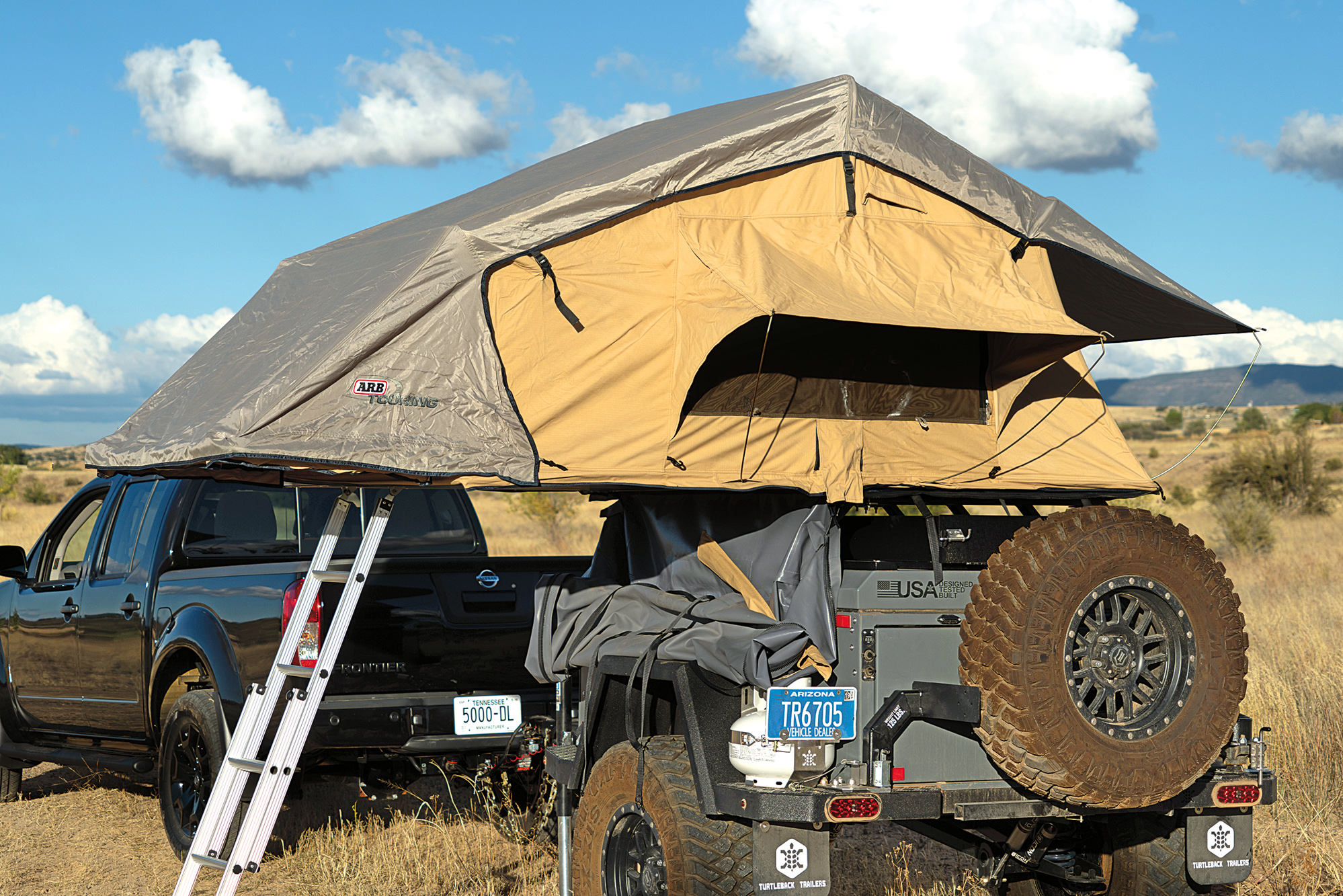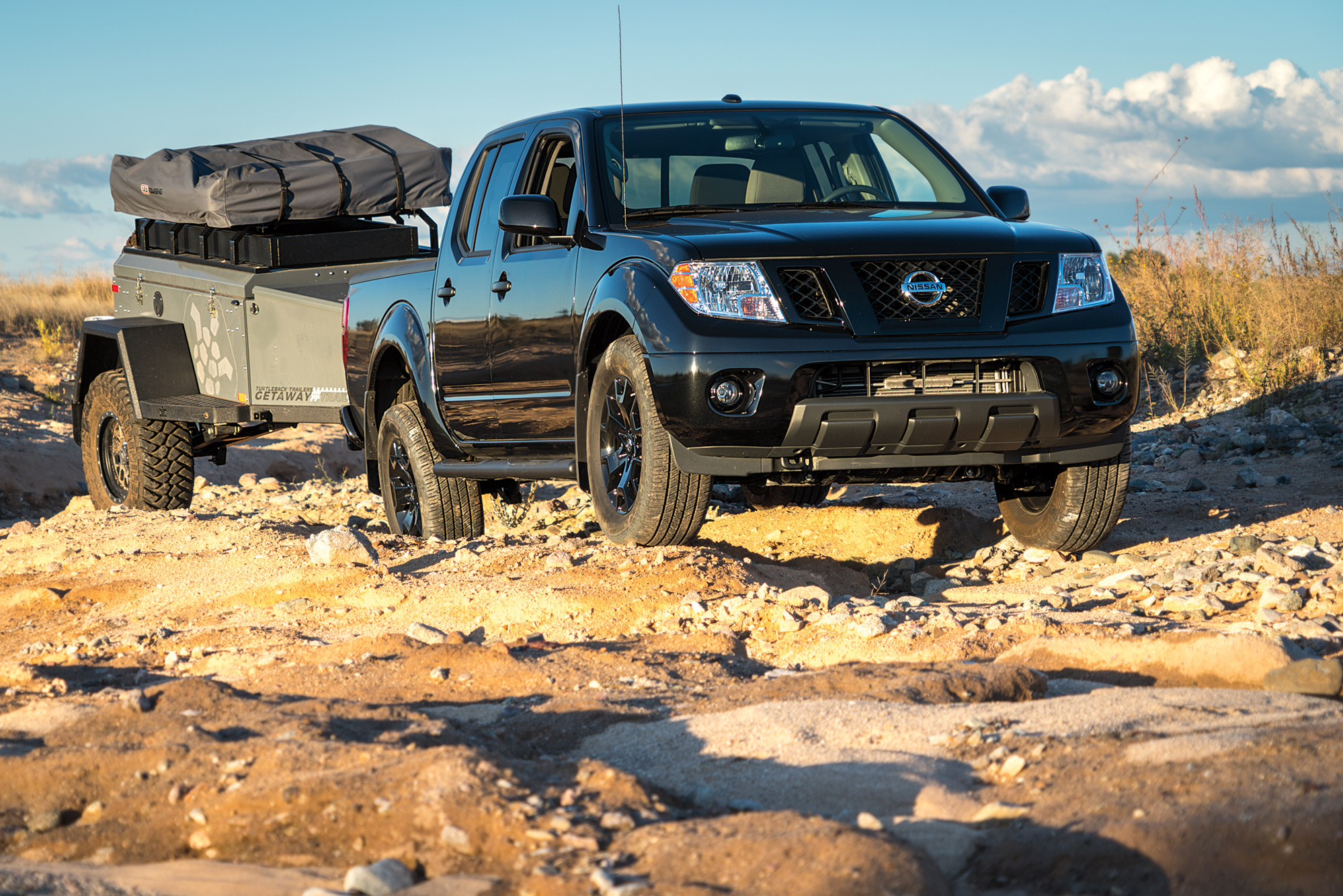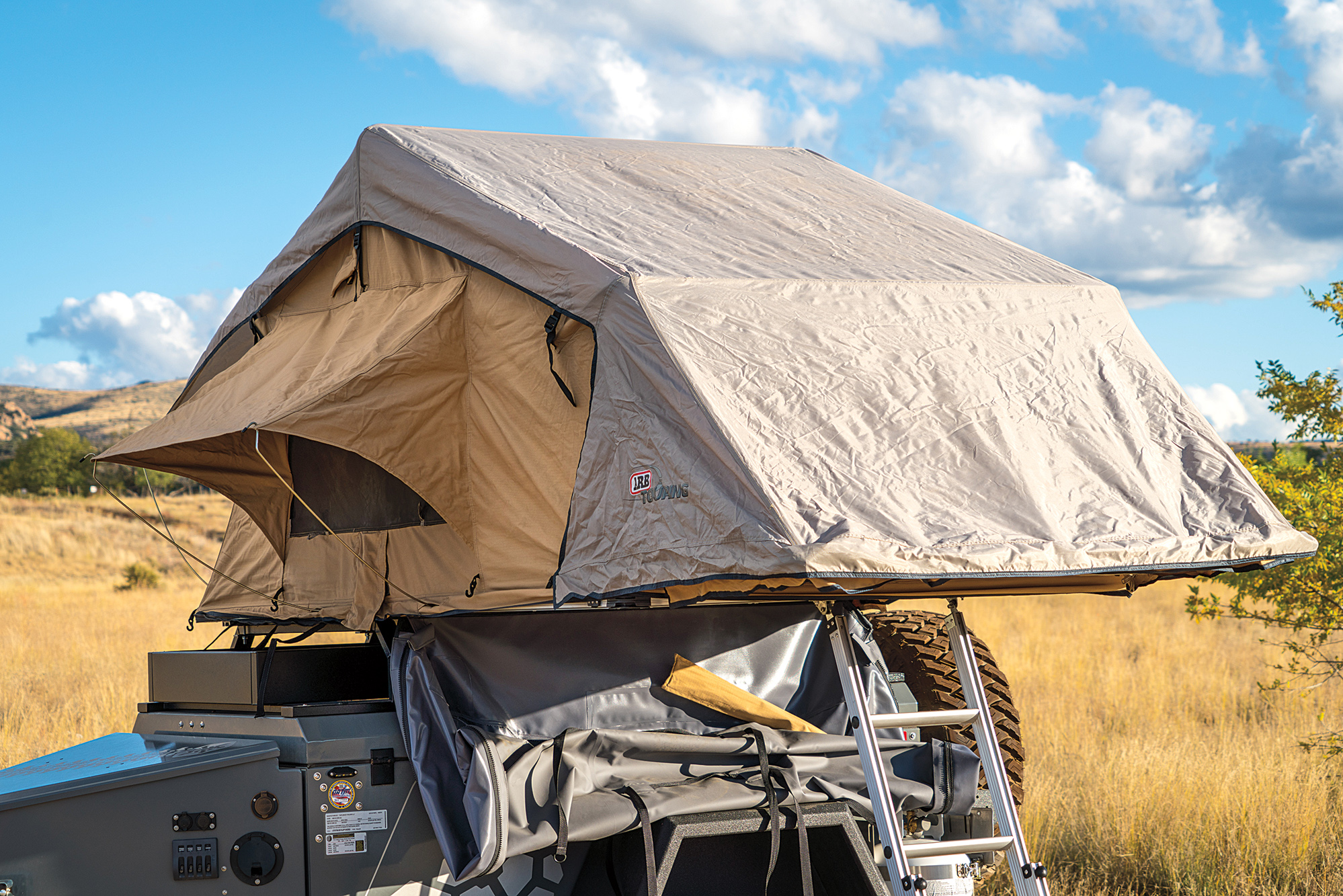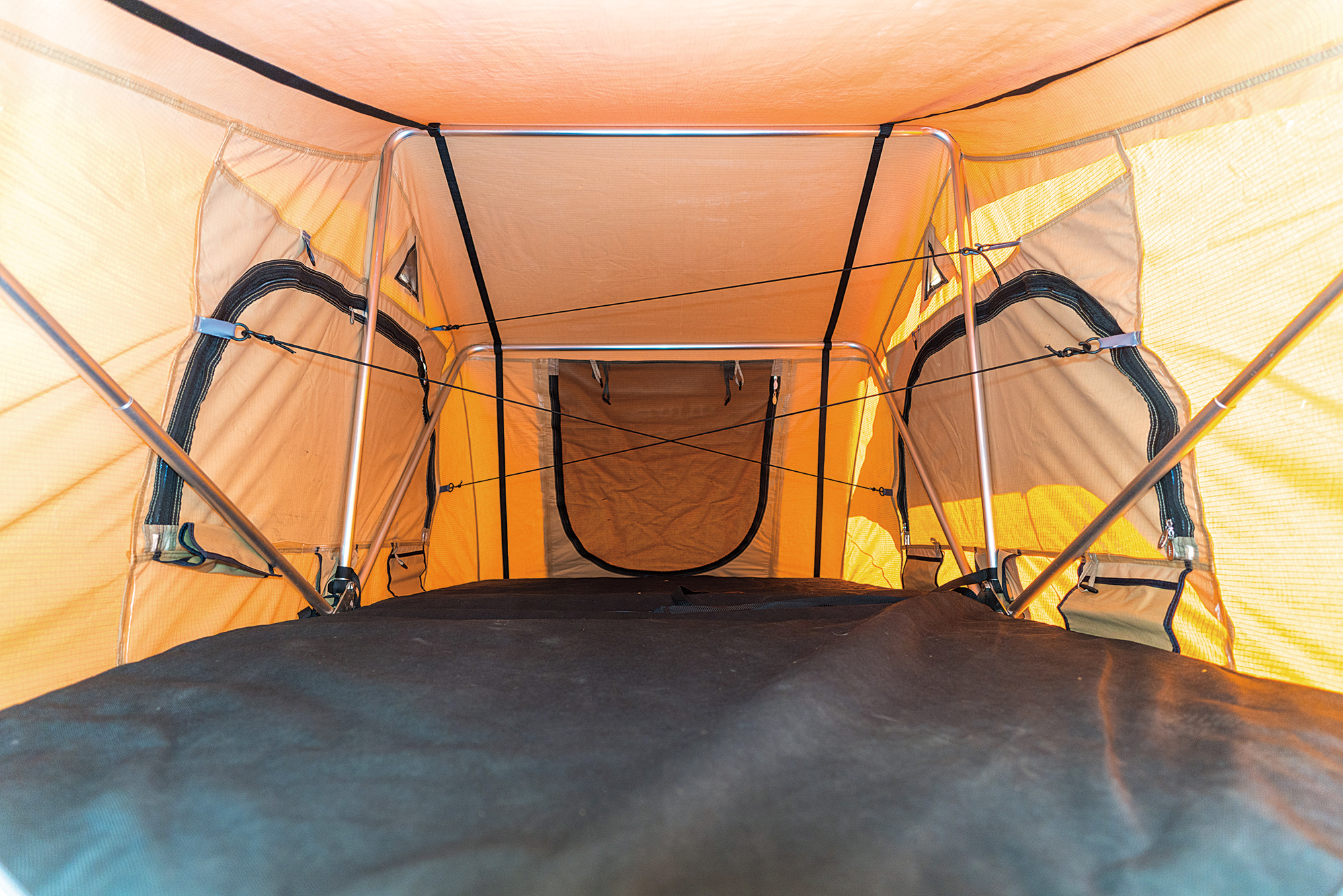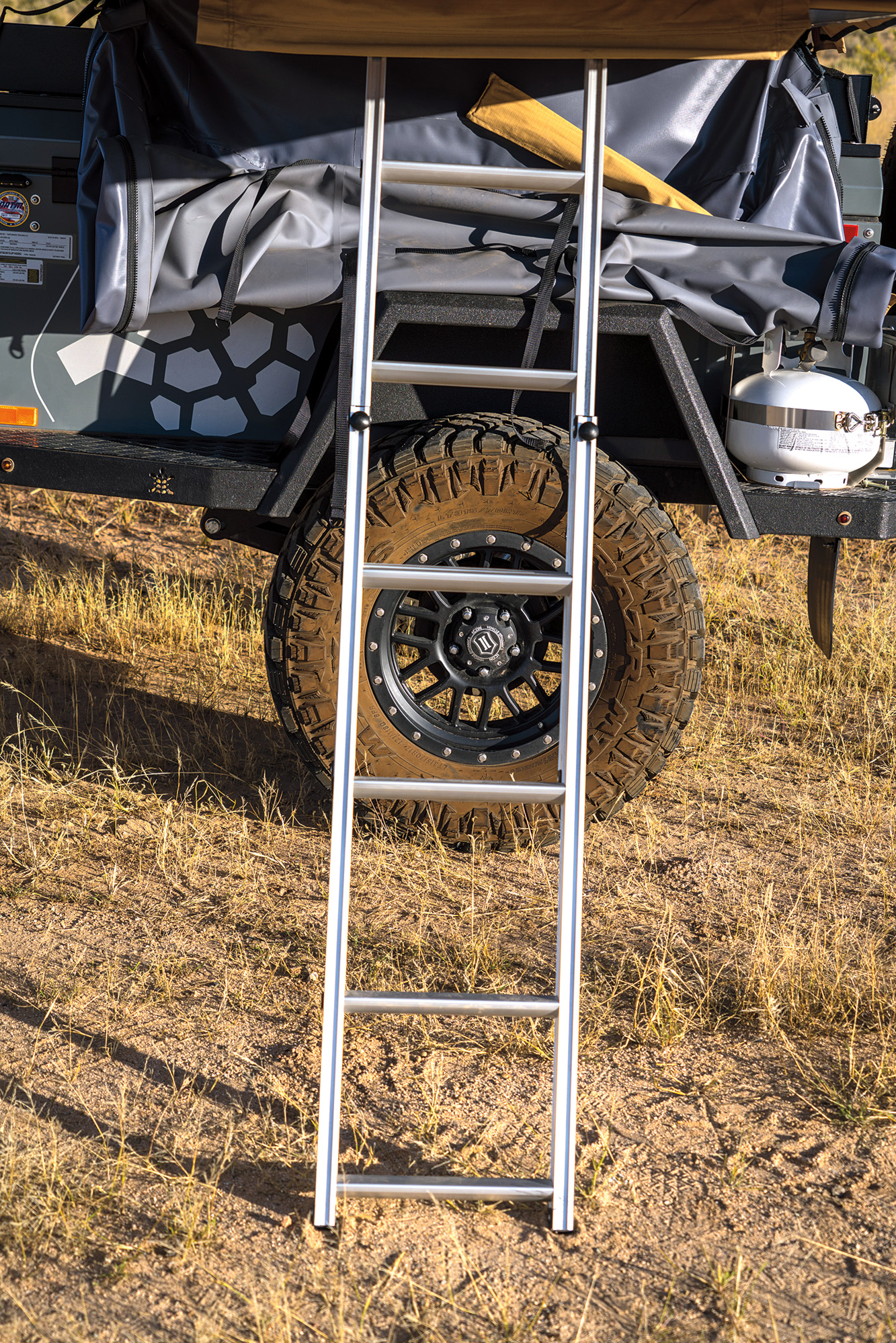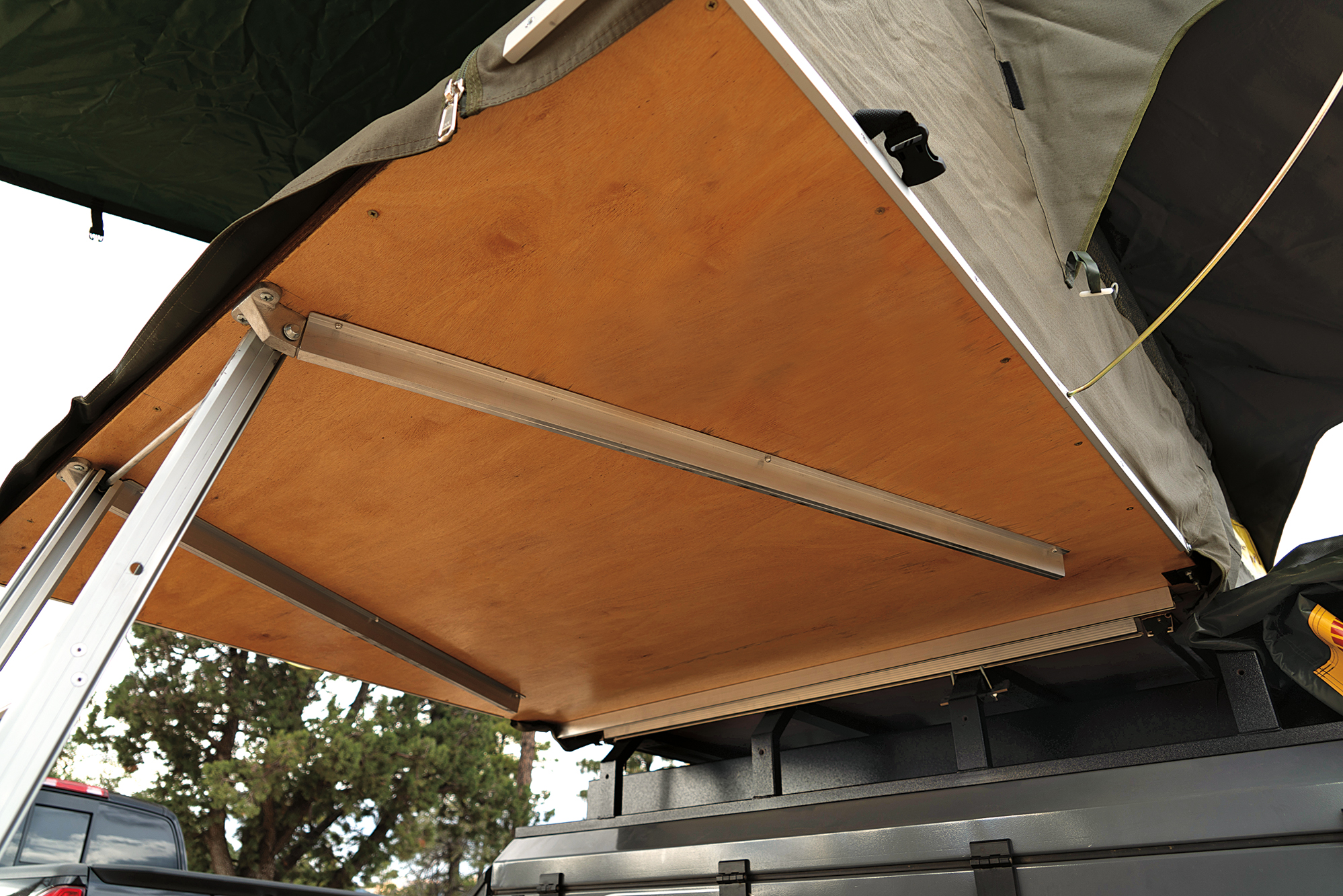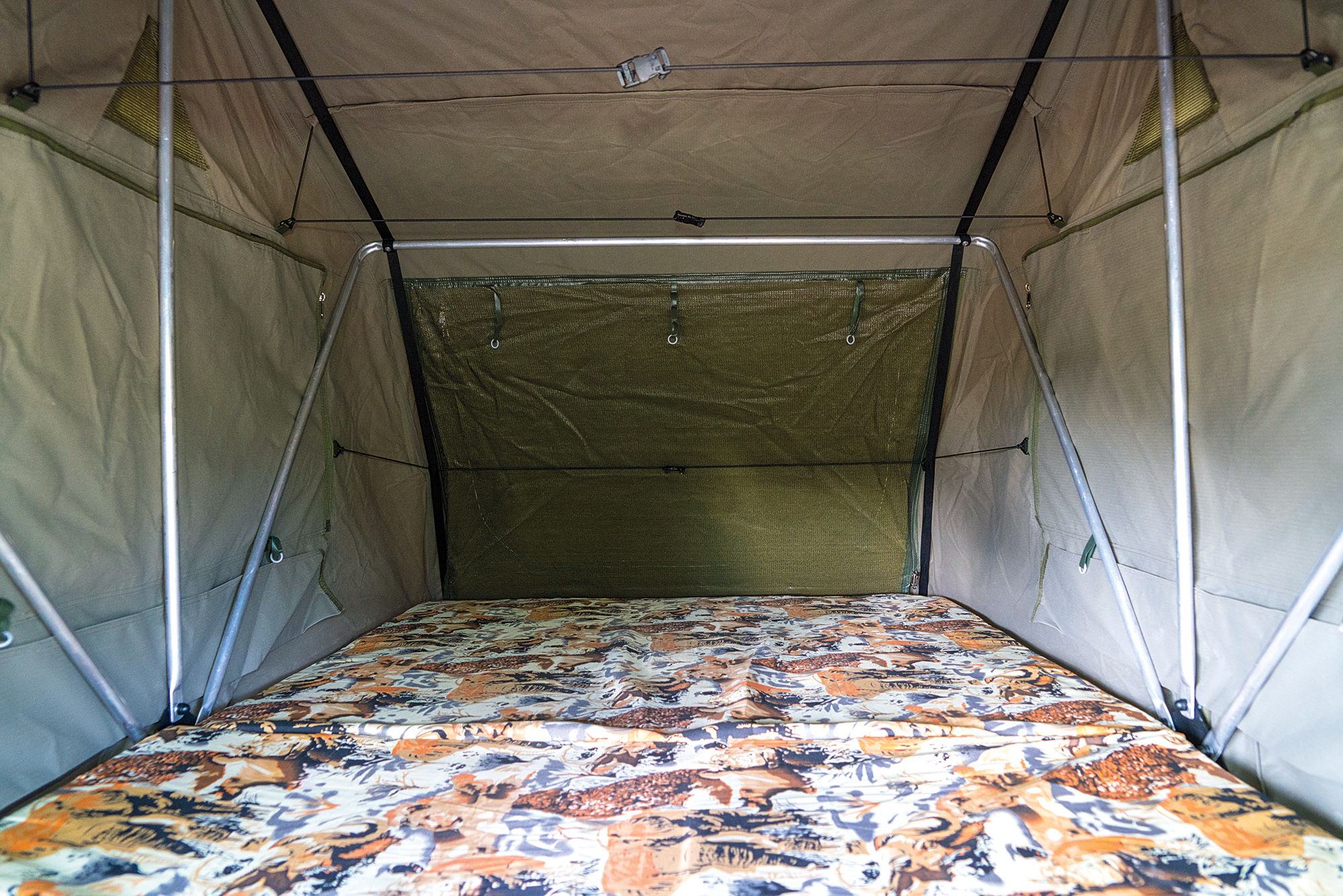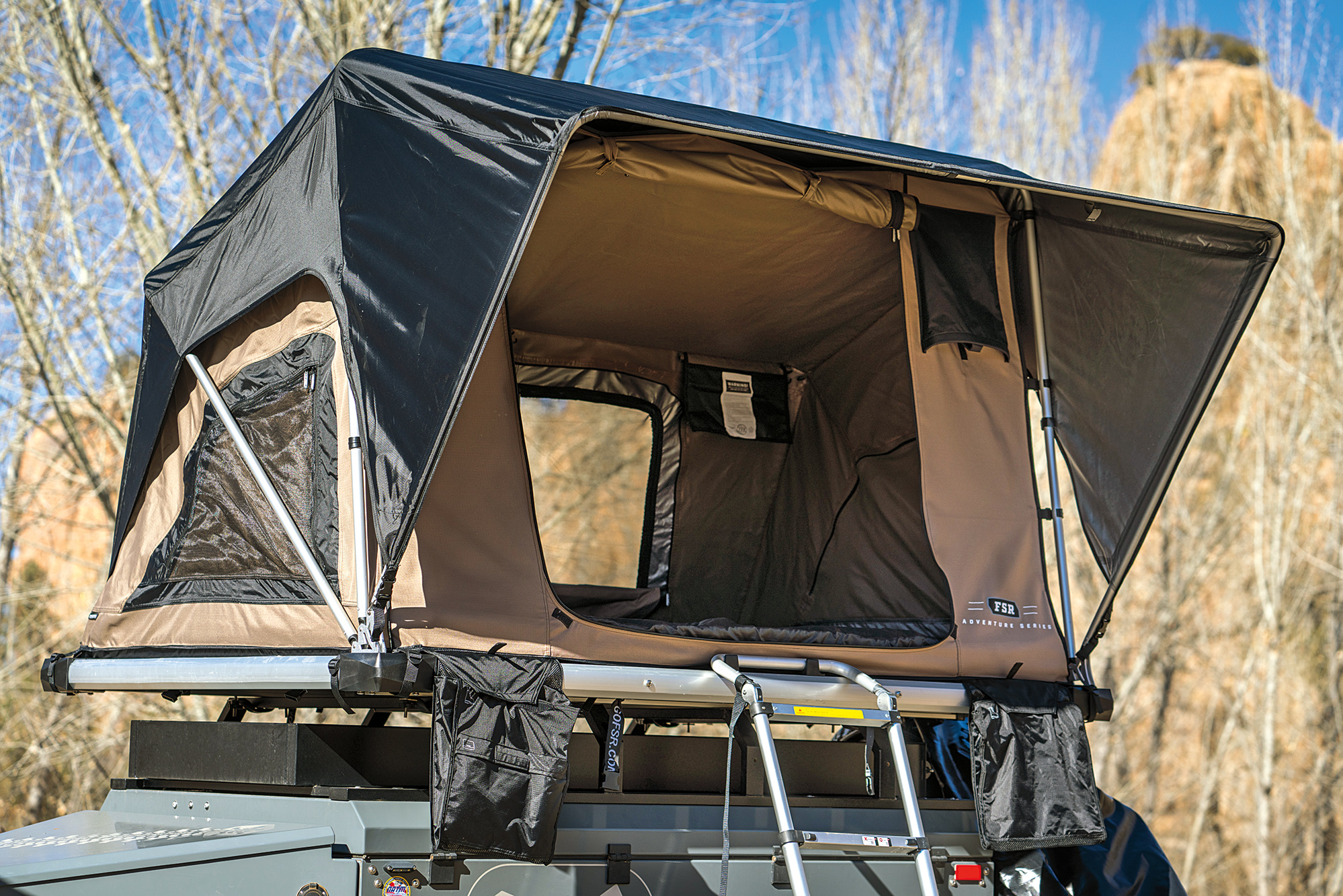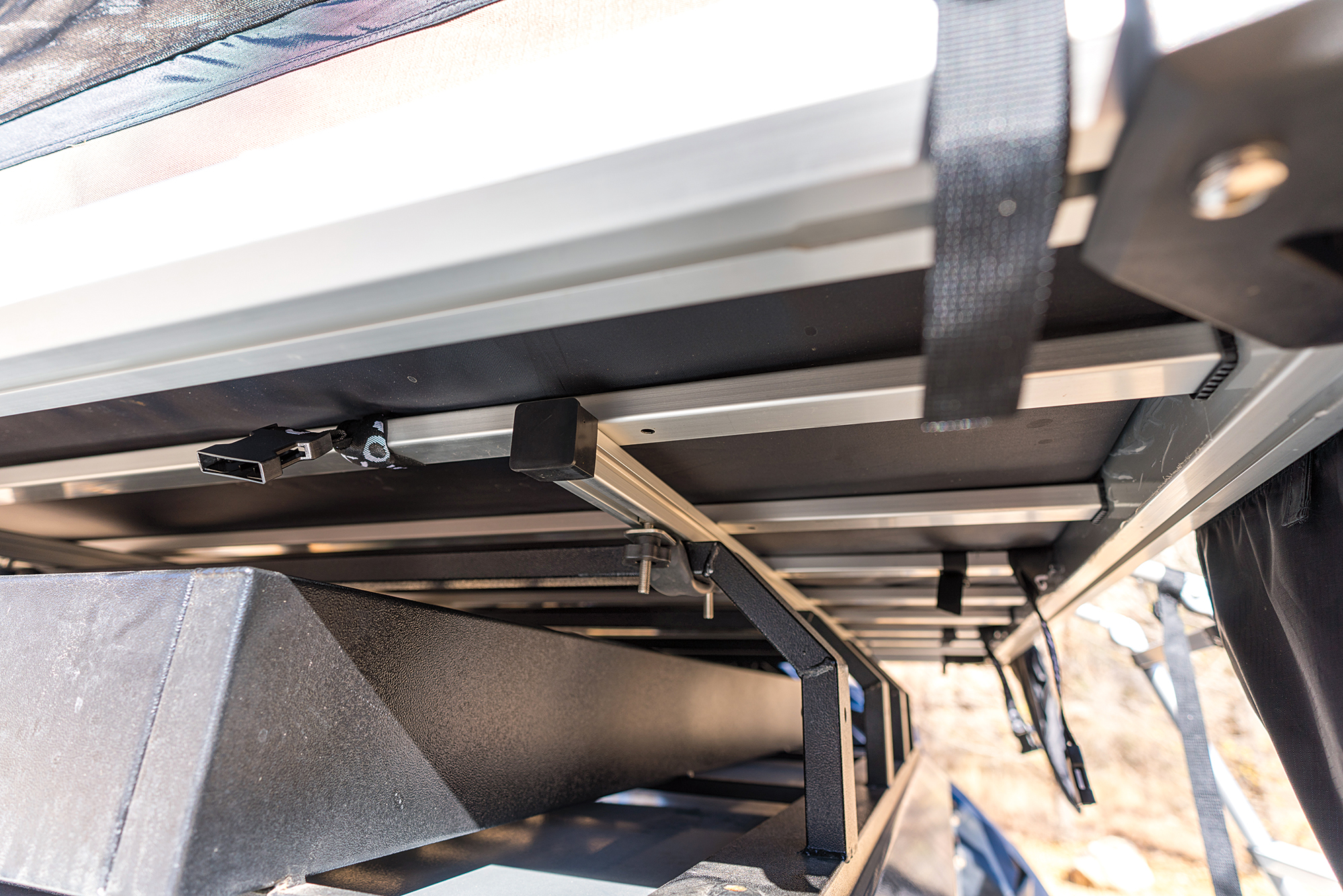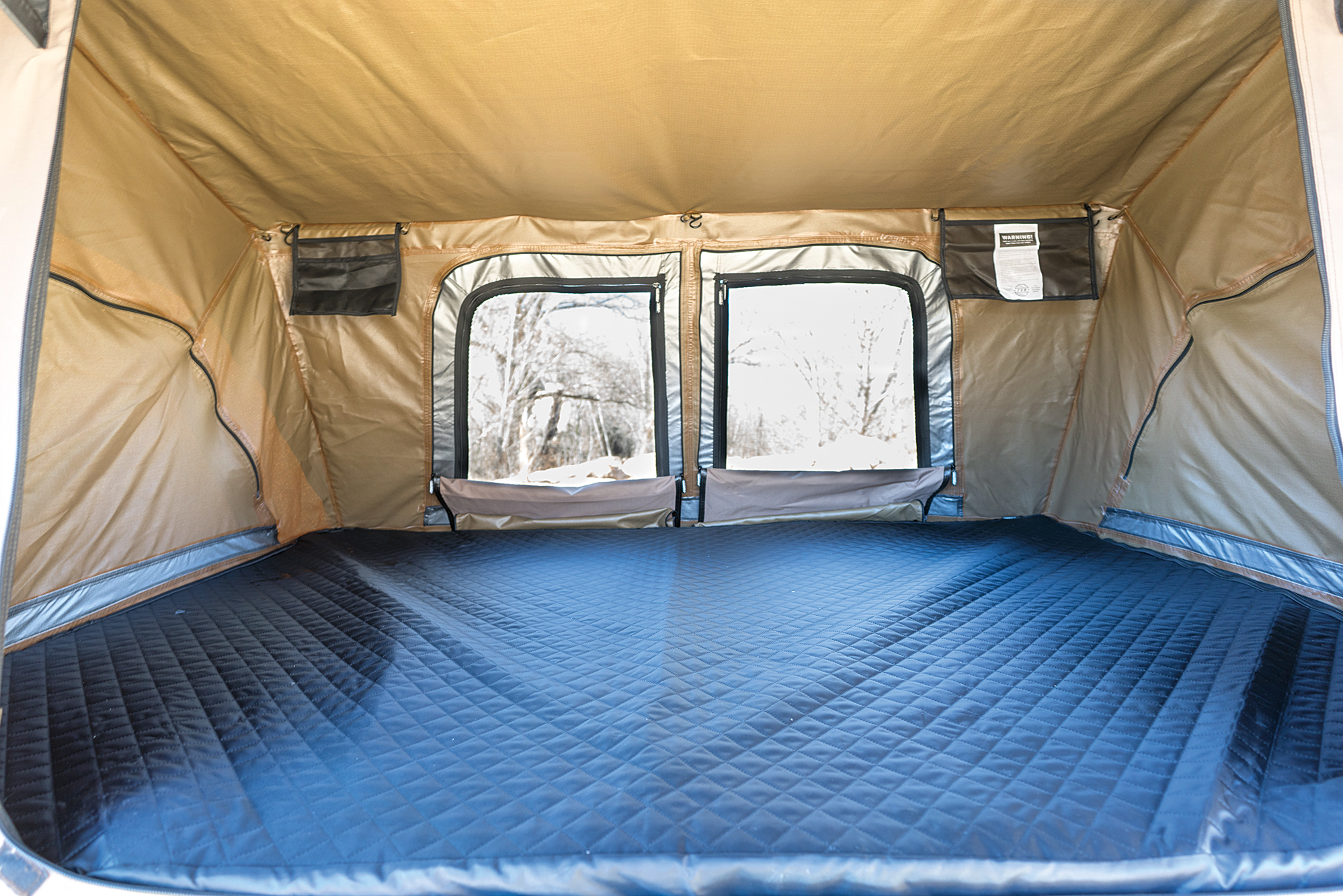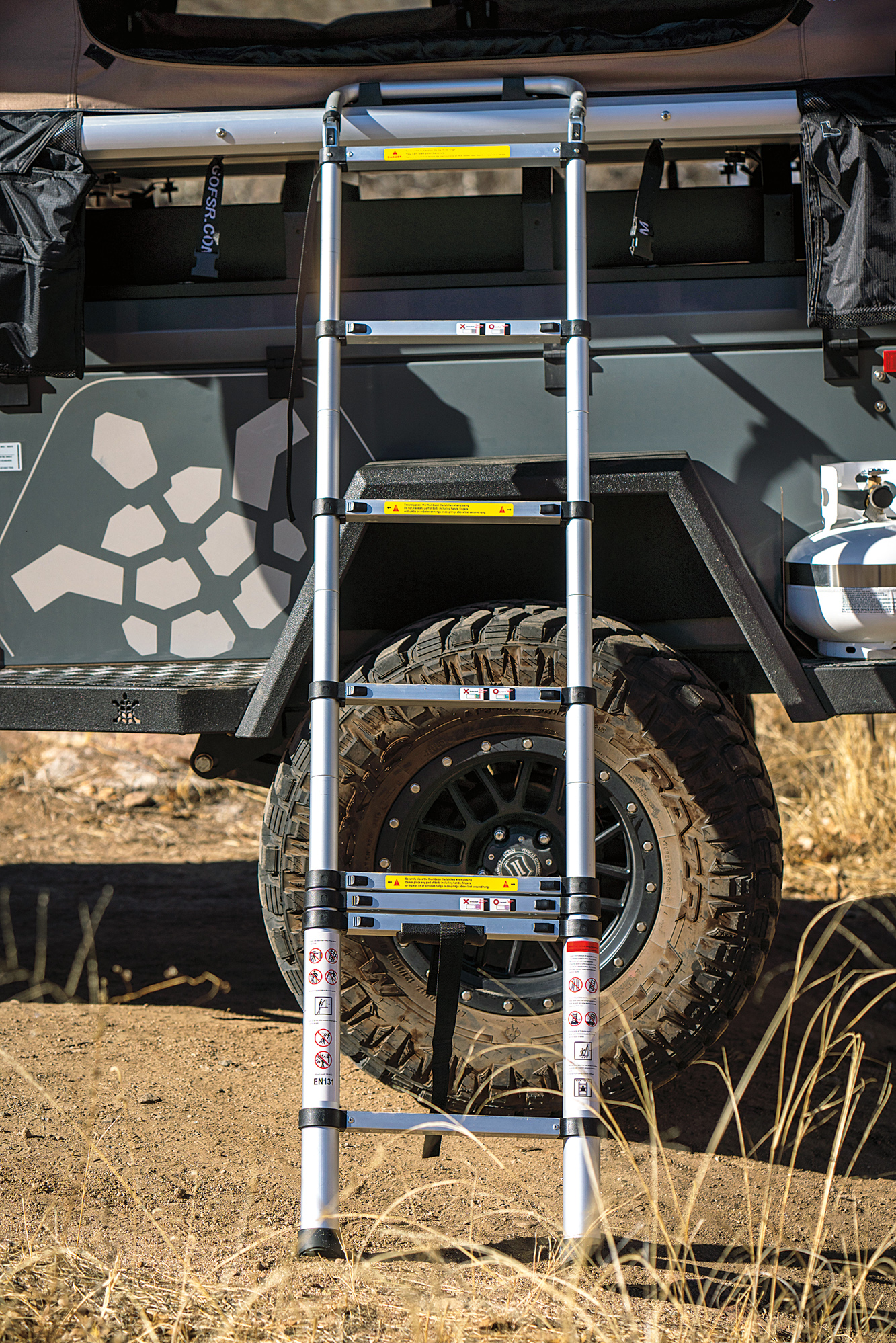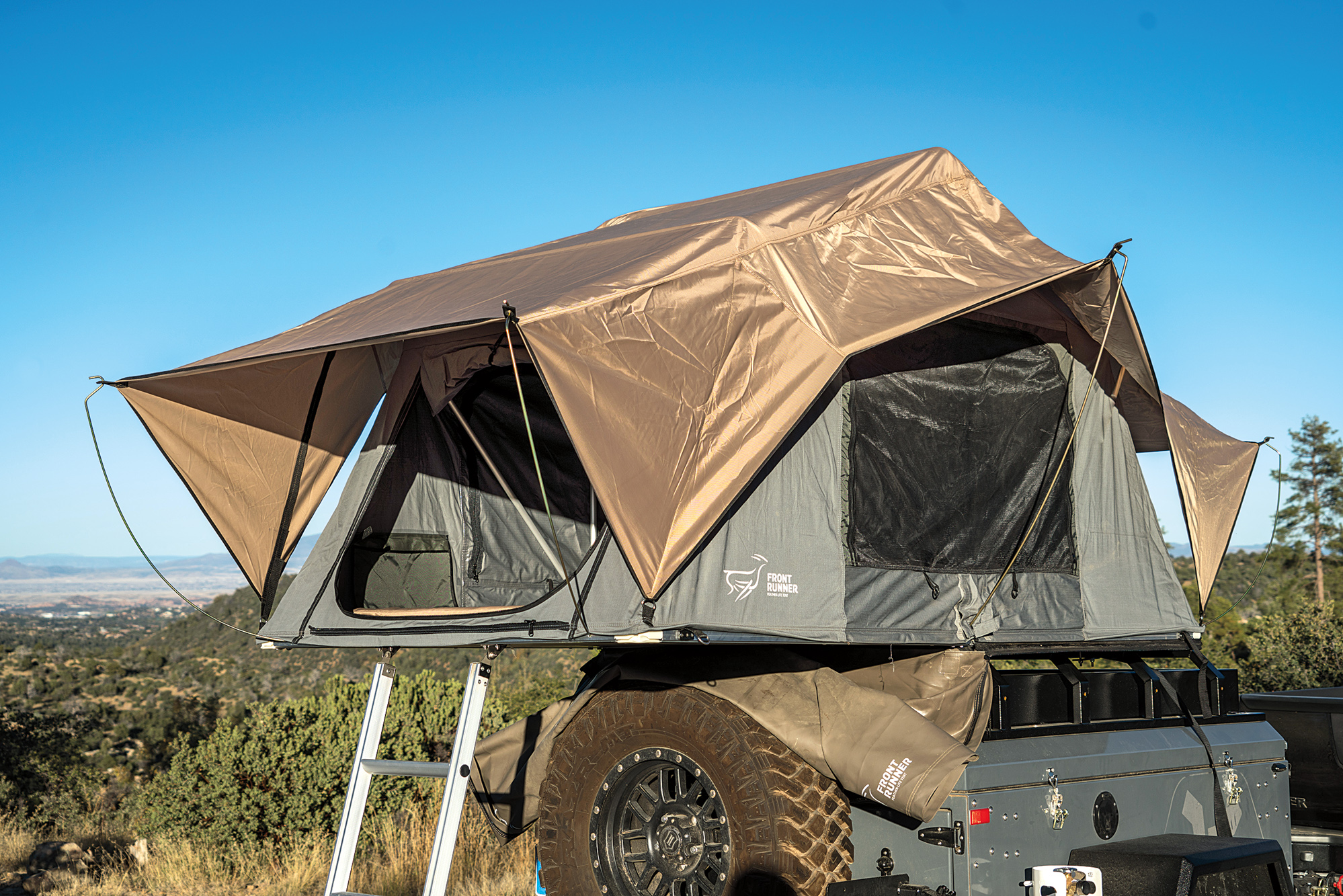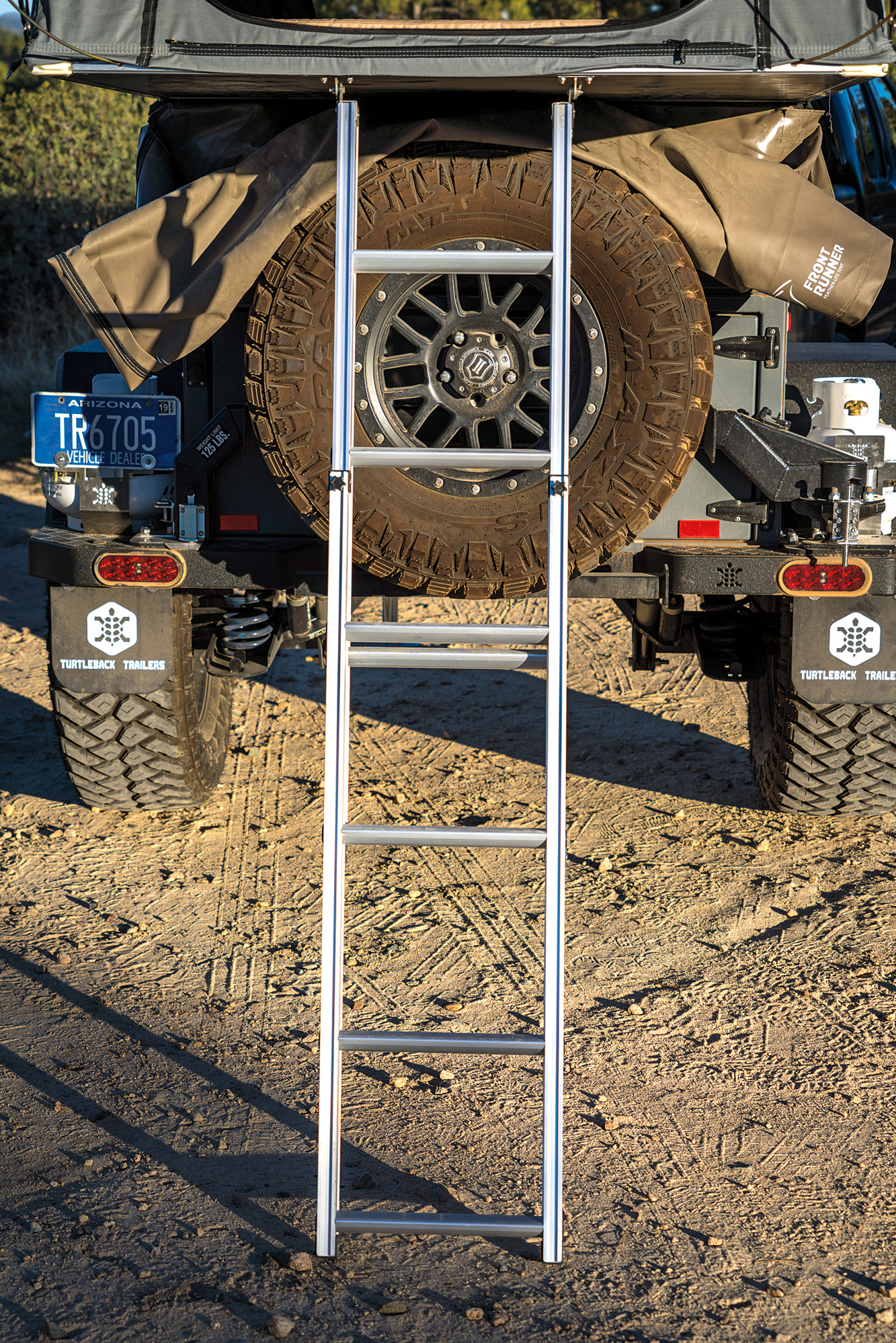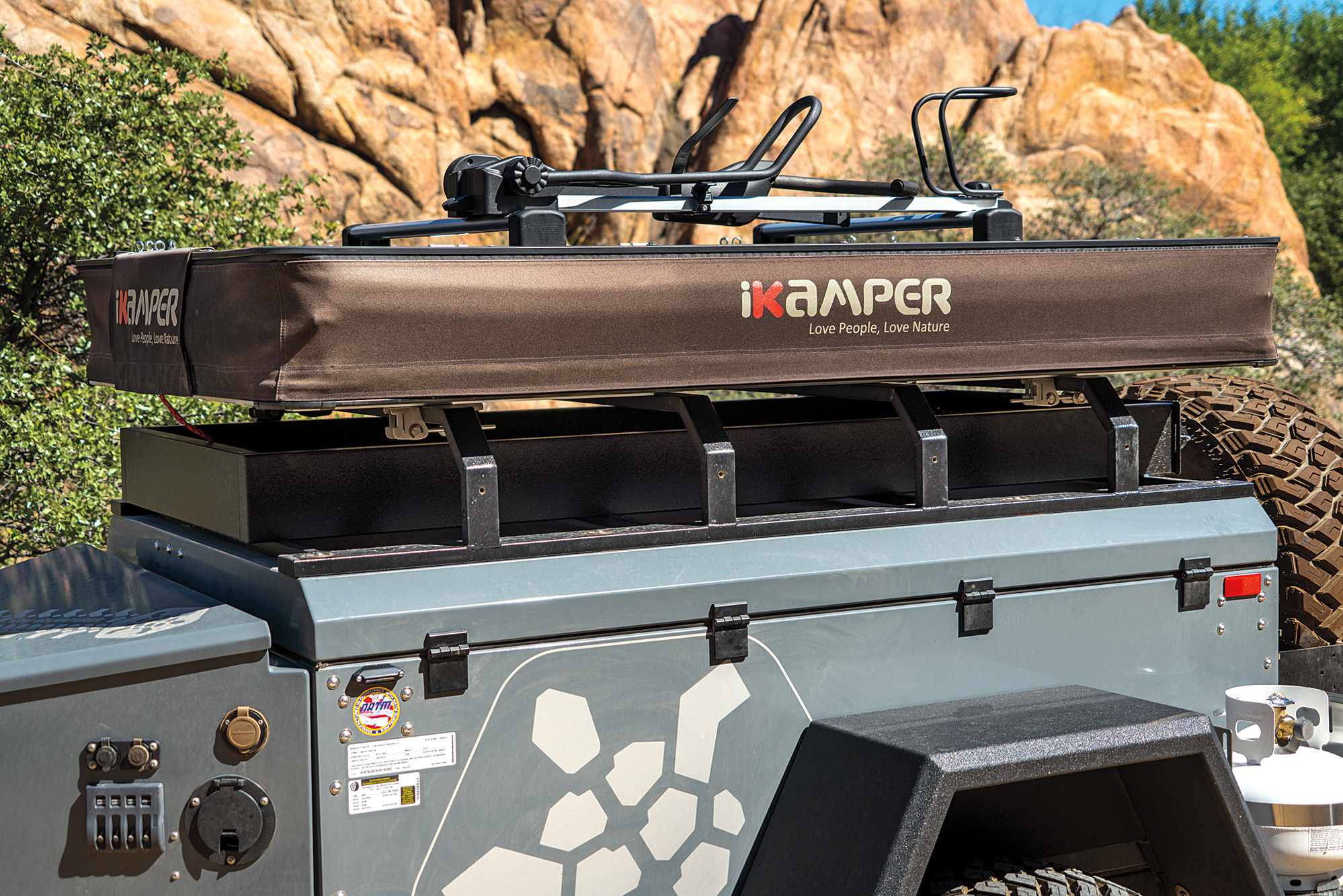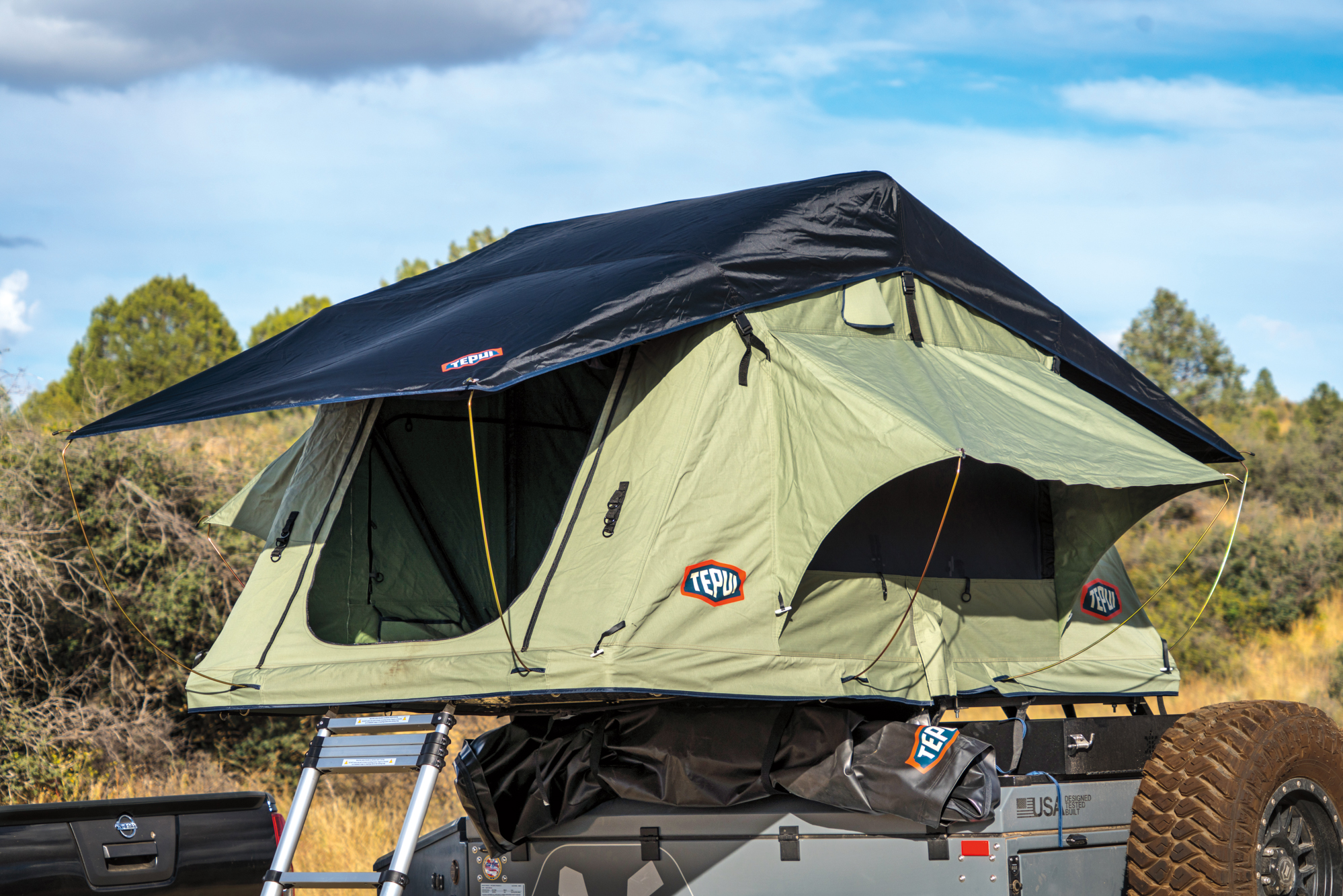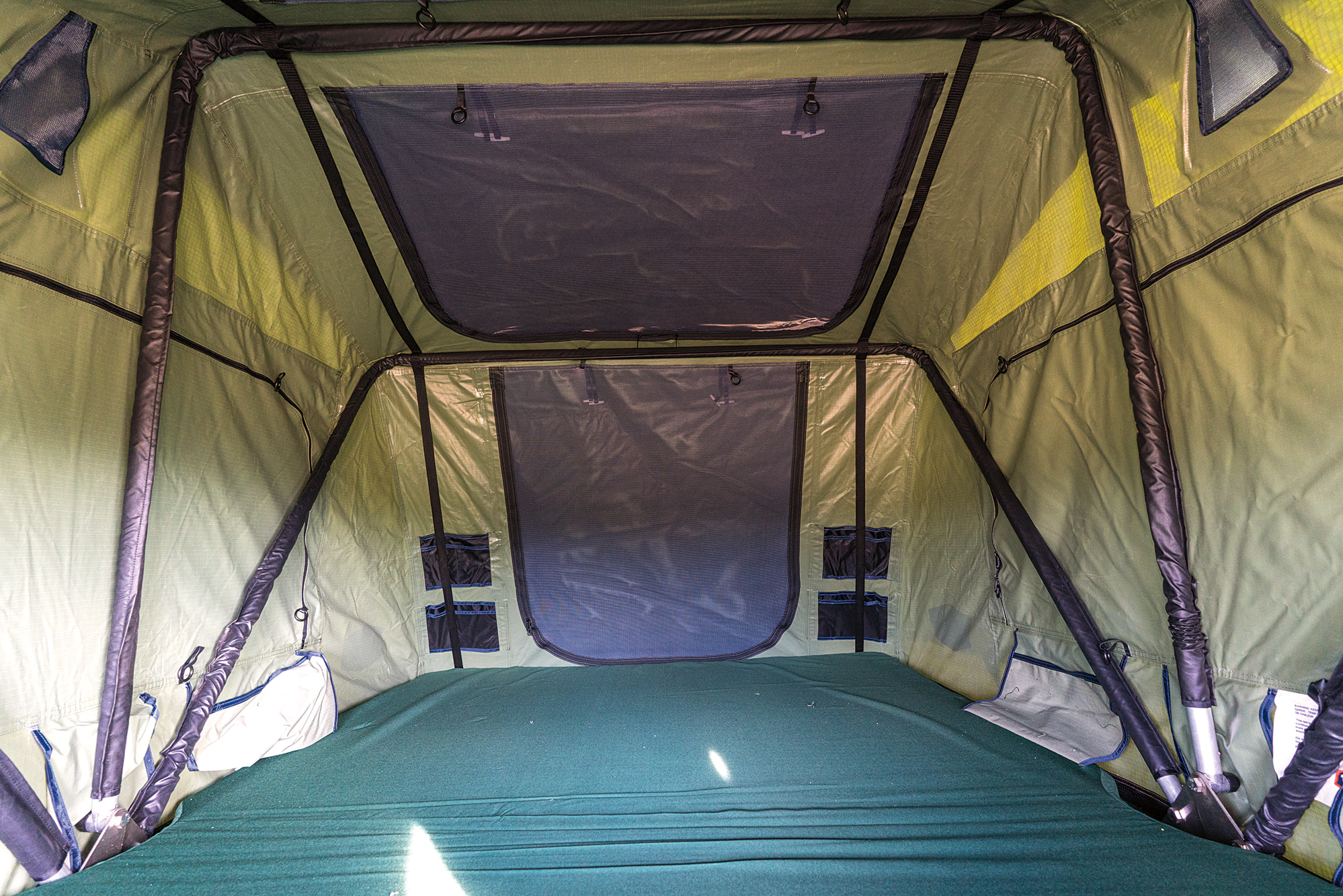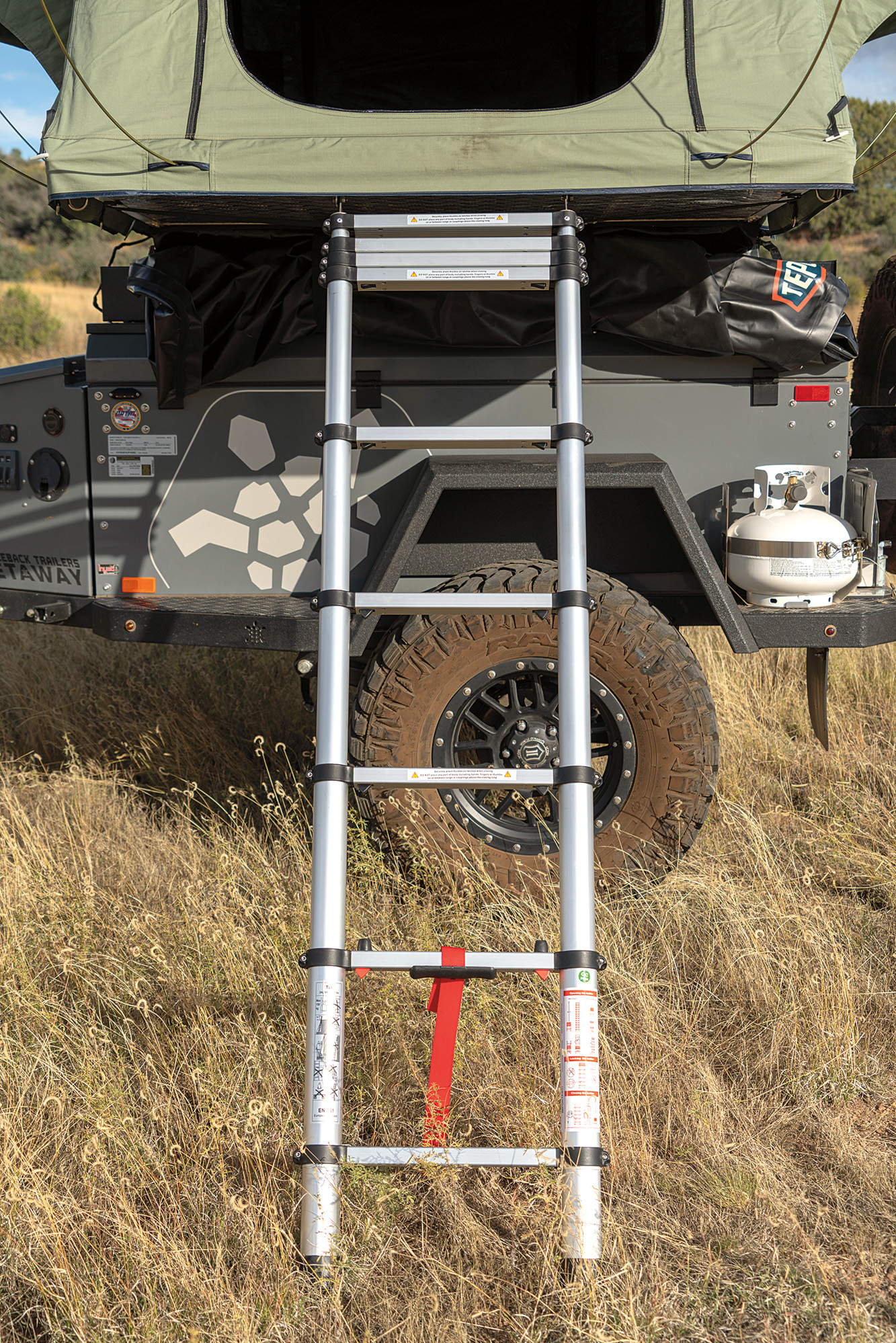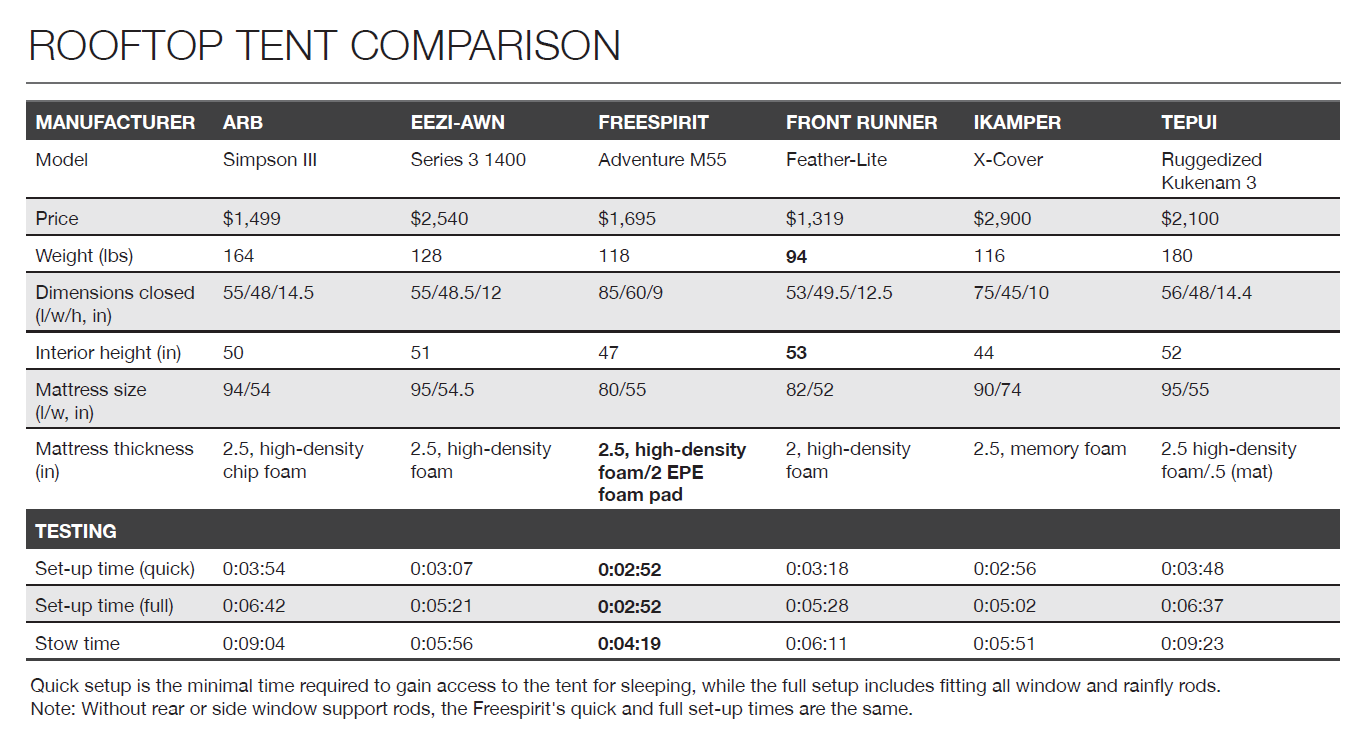Editor’s Note: This article was originally published in Overland Journal, Spring 2019.
I still remember how -57°F felt, a cold beyond description, as if all life had escaped along with my body heat. I recall fighting against the cover of the roof tent, the vinyl becoming hard as stone in the frigid temperatures of the northern Canadian winter, and how good it felt to crawl into the tent with its thick mattress and heavy canvas protecting me from the arctic chill. Another time, I distinctly remember the sound of a lion grunting as he paced the perimeter of our camp—it’s burned into my memory, along with how grateful I was to be in a roof tent, far above the South African bushveld. So many times I have praised and cursed these overlander tree forts, bemoaning their weight and complexity, or sighed in relief as I set one up in the rain, amidst a campsite swamped with mud and rocks.
As with any accessory, there are pros and cons to fitting something to our vehicles, with few items earning such compelling arguments for and against at both extremes. Despite this, rooftop tents (RTTs) are more popular than ever, now on display in REI and frequently seen mounted to the tops of Subarus. Also gone are the days when the only high-quality and expedition-grade RTTs were made in South Africa and Europe. But more importantly, we are finally seeing innovation and unique solutions for the wants of RTT buyers. The style, weight, quality, and setup now varies significantly from the original Brownchurch rack tents of 50 years ago—all the better for buyers in the 21st century. At Overland Journal, we love a good test, so we took a few months and dozens of nights in the field to set up, tear down, and generally beat about six popular models from reputable brands.
SELECTING A ROOF TENT
Choosing a roof tent is no longer the easy process of deciding which canvas color you like best, as there are now over 50 different brands and hundreds of models. We are seeing soft-shell tents utilizing hardshell covers or no covers at all. There are tents available for under $500 on Amazon and other units costing nearly 10 times that much, with everything in between. The quality gap has also narrowed considerably, with ruggedized units now being manufactured in Asia, along with discount models currently being produced in South Africa. Despite all this, several attributes are critical for long-term use and reliability.
MORE IS NOT BETTER
Dozens of accessories are often included with the model along with greatly increased complexity and weight: massive overhanging annexes, heavy and difficult to set up awnings and walls, and a litany of nets, straps, loops, and even motors to potentially fail in the field. Certainly, a wall set or annex can be a valuable addition for large families desiring additional sleeping space, but in most cases, accessories like this are a giant pain. They also add notable weight and setup time to the RTT and are rarely needed in practice. All of the tents tested are shown without walls or annexes.
WEIGHT IS THE ENEMY
It is easy to exceed the roof load limits of most SUVs once a RTT and fullsize rack are affixed. There are only a few vehicles with roof load ratings that exceed 200 pounds, yet we often see oversized tents mounted to full-length metal racks complete with fuel cans and Hi-Lift jacks. This means that smaller and lighter tents may have to be selected and often mounted to simple crossbars. And there are units that weigh in at only 100 pounds or so, which will still allow the use of a proper aluminum rack too. Total up the weight of the tent, rack, accessories, and any bedding to be sure the vehicle roof is not overloaded.
FAST IS FRIENDLY
Some tents can take 15-20 minutes to set up if the annex and all poles are utilized. That is often not practical for how many overlanders travel. This process can demand significant time and effort each day just preparing or closing up a tent; even more so if conditions are poor. Pay extra attention to the cover, which can be a struggle in certain models if constructed too tight to pull over the bows and fitted with undersized or difficult to operate zippers.
COMFORT IS KING
One of the best arguments for buying a roof tent is for a good night’s rest, so test out the mattress at an overland event or read reviews and comments on comfort before buying. I have seen buyers need to install memory foam and even air mattresses to augment the poor support of the stock pad. Look for 60-millimeter minimum thickness and preferably dual density. Even better, some tents are now using a padded floor or underlayment to facilitate comfort. Also, thicker canvas walls reduce light ingress, allowing for the luxurious option of sleeping in well after sunrise.
QUALITY ALWAYS MATTERS
As with anything we count on in the backcountry, quality and durability are paramount, or we are better off not having it at all. Like the cheap winch that doesn’t work when we need it, a roof tent that fails in the first heavy wind is a liability. In reality, an $800 ground tent will be superior on all counts to an $800 RTT, so avoid the bargain RTTs all together. The devil is in the details—the best things to look for are zipper size, cover thickness, tent wall stitching, and method of waterproofing.
TESTING
While much of evaluating a roof tent is subjective, many elements can be reviewed objectively, and the goal was to incorporate both sets of criteria. Even 10 years ago, the landscape of roof tents was vastly different to today, with nearly everything following the South African design model of a traditional clamshell and supporting ladder. The abundance of model choices now available is a huge win for consumer selection, but does muddy the water and make it challenging to determine real quality and innovation above the marketing rhetoric. As a result, we selected six models from known and proven manufacturers, while also allowing for representation from newer companies that have demonstrated genuine innovation. Our lineup includes everything from the wood and canvas Eezi-Awn to the innovative iKamper and many options in between.
For our objective review, we compared the weights of the units along with mattress thickness and deflection. We timed the quick setup, which is the minimum setup required to sleep, and also the full setup, which included every pole and vent. The third timed effort was stowing the tent properly, in ready-to drive- down-the-trail mode. The evaluation biased heavily toward setup convenience, as I have witnessed far too much frustration in the field from owners of cumbersome models as they fought fragile zippers and complicated wall sets. The final objective review included inspection of the hardware, stitching, and weatherproofing.
Subjective considerations are important to any test, but I worked to avoid those that might be heavily influenced by my own bias and eccentricities. I included notes on aesthetic and design, but they factor minimally in the final scoring. Of a particularly subjective nature is evaluating mattress comfort, which is heavily influenced by the sleeper’s preferred position, body weight, and preferences. As a result, I provide specifics along with my impressions. Despite all this, clear leaders arose early. Roof tents continue to grow in popularity and diversity, but the fundamentals remain: quality, durability, comfort, and setup rule the results.
ARB
Simpson III
The best tent for overall interior space and privacy.
High-quality cover
Covered entry
Includes annex walls
Good value
Awning eliminates views from ladder side
Mattress may be too soft
for some sleepers
Cover difficult to fit due to awning poles
Removing the tent from the packaging reveals a notably thick and durable cover made from UV-stabilized and welded PVC, held in place by a robust three-side zipper and three girdle straps. Installation was easy using the supplied captive bolts, extrusion plates, and spanning crossbar plates. Setup was straightforward but does take a little longer than the competition, mainly because of the three cover straps, cover zipper, tent compression straps, and the overall tight fit of the cover at the awning pole corners. Once set up, the unique features of the Simpson are more apparent, including the extensive weather protection the rainfly and awning provide to the tent and occupant entry. This also gives a sense of the unit being much larger overall, especially if the included annex is used and the user can gain access to the tent from within the privacy of the annex walls.
I found the 2.5-inch, high-density chip foam mattress to be comfortable, but less supportive than some of the best examples in the test. The interior is bright from the lighter-colored, poly-cotton ripstop canvas tent walls. The process of stowing the tent is started by collapsing the awning poles and then folding the tent over on the base. Some time is lost trying to fit the durable cover over the awning poles and then running the zipper around the edges. The Simpson III is a high-quality, high-value option, particularly when the free annex walls are considered for those that need the extra space.
$1,499 | ARBUSA.COM
EEZI-AWN
Series 3 1400
The roof tent that your heirs will fight over.
PROS
Quality materials throughout
Easy setup with no cover zipper
Large doors and windows
Thick tent canvas blocks most light ingress
CONS
Insect screens allow gnats and no-see-ums in
Ladder requires optional extension for taller vehicles
Ladder adjustments need drilling
While roof tents may seem like a recent trend, they have been around since practically the first automobiles, and Eezi-Awn has been around for over 35 years. The founder, Jack Stuhler, and his son Jess are not just manufacturers, but passionate overlanders. This tenure and commitment are reflected in the quality of their tents and their reputation for product durability. I have used Eezi-Awn tents for hundreds of nights. The Series 3 is the latest model of their expedition-class roof tents, combining wood, canvas, and aluminum.
Setup is one of the easiest in the test, taking barely three minutes. The 700-denier PVC cover features welded seams and is removed by loosening a ratcheting strap and folding it up; this saves considerable time and energy. With the cover off, there are two compression straps to undo and then a steady pull on the attached ladder to pull the Series III open. The removable PVC flysheet and the two side windows are held open on both door ends by spring steel rods. I noted that the rods insert into steel sleeves; this makes fitment effortless and reinforces the attachment point.
Further inspection of the tent shows quality materials at every corner, starting with the ladder extrusions and extending to the double-stitched ripstop canvas tent body. The base is made from 9-millimeter marine plywood, reinforced with meranti timber and aluminum angle. Additional rigidity comes from long sections of extruded aluminum on both the rack side and ladder side. This all translates into a stable and durable structure. The ladder is extremely sturdy too but is one of the more difficult in the test to work with. The ladder length needs to be set by drilling into the extrusion for the height of the vehicle, but that can prove problematic in uneven terrain and necessitates an optional extension for taller 4WDs. The ladder is uncomfortable with bare feet, each rung a narrow metal step. Inside, the thick canvas proves a dark cave against light ingress, and the 2.5-inch, high-density foam mattress is covered in a fun African print—you can almost hear the lions roaring in the distance.
$2,540 | EEZI-AWN.COM, EQUIPT1.COM
FREESPIRIT | VALUE AWARD
Adventure Series M55
Wow, that mattress is comfortable, and no transit cover zipper—Valhalla!
PROS
Fast setup
Comfortable mattress
Supportive anti-condensation underpad
Low-profile design reduces overall vehicle height
CONS
Minimal weather protection on some windows
Full-length design uses all roof space for most vehicles
Less interior space than those with the same footprint
Freespirit came to the market with the goal of doing something unique, and their new Adventure Series achieves that for both the weekend warrior and year-round traveler. The Adventure lineup includes everything from the 55-inch-wide manual model tested here, to a four-season-rated, tri-layer unit, and even an electric unit that sets up with a remote. These tents are also different from the others in the test as the models do not clamshell open, but instead pop straight up, reducing weight and simplifying setup.
Deploying the tent starts with removing the zipperless PVC cover, which is accomplished by unclipping two girdle straps and four corner clips. The tent is then pushed up from the rear window side, and a crossbar is clipped into position. Lastly, the door awning is pulled out and held in place with a hinged rafter pole. There are no window rods to install, which makes the quick setup the same as the full setup. This convenience does come at the cost of limited rainfly protection for the side and rear windows if they are left open for ventilation. There are two large vents next to the front door that help with inclement weather airflow. Freespirit also sells a tri-layer interior wall set that converts this tent into a true four-season solution.
While it is easy to focus on the rapid setup, there are other benefits to the design, like the tall roof height and superior view out of the massive door and rear windows. The ladder does not support the tent, so it can be slid from front to back along the aluminum base extrusion, which allows for opening rear doors, etcetera. In my experience, the greatest advantage of the design is the additional space it affords to the mattress. This is without question the most comfortable bed in the test with a quilted 2.5-inch high-density foam mattress and underlayment pad. The pad rests on an aluminum frame grid that reduces weight and acts like a box spring—innovative indeed.
$1,695 | GOFSR.COM
FRONT RUNNER
Feather-Lite
For the minimalist overlander that actually reads roof load warnings.
PROS
Lightest in the test
Low profile when stowed
Minimalist design reduces set-up time
CONS
Cover zipper is lighter duty
Moderate wind can dislodge rainfly poles
Famous for their aluminum roof racks and overland accessories designed in South Africa, Front Runner has expanded into roof tents and other soft goods in recent years. Across their lineup, their designs are influenced by Stanley Illman, one of the company founders and a lifelong overlander. This perspective resulted in a lightweight and low-profile roof tent priced at a notable value.
Unboxing the Feather-Lite requires minimal assembly, as the roof rack extrusions need to be mounted based on the desired orientation of the ladder (to the side or the front/back). The supplied mounting hardware slides into the aluminum extrusions and clamps to the crossbars with thick plates or to a rack with available brackets. The cover is made from PVC and uses two straps over the top to prevent billowing at highway speeds. Setup starts with unzipping the cover, and the zipper was lighter duty than several in the test. With the cover off, a few compression straps are all that is left before pulling the tent open. The rainfly is large and provides expansive rain protection. It uses fewer poles than other tents, relying on a single spring steel rod for the side windows. The rainfly can be completely removed for additional weight savings in gentle climates. However, this function can also allow for the fly poles to pull out of the tent sleeves in even moderate winds.
The interior is simple, which is a positive for weight and complexity. The roof also includes a ventilation panel with bug netting for greatly improved ventilation. The mattress is nearly a foot shorter than the overall base length, but it provides the benefit of a small area to store shoes and other dirty items off of the mattress. It also reduces the overall weight and is still long enough for tall travelers. I also appreciated that the side window panels zipped from top to bottom, allowing for adjustment to the airflow while still providing privacy. This tent is intentionally minimalistic, and this rewards the buyer with one of the lightest (94 pounds), lowest profile (11.7 inches) tents on the market.
$1,319 | FRONTRUNNEROUTFITTERS.COM
IKAMPER | EDITOR’S CHOICE
X-Cover
Innovation abounds with this lightweight, easy-to-deploy wondertent.
PROS
Allows for top-mounted crossbars and accessories
Lack of traditional cover
speeds setup, reduces weight
Unique and frustration-free mounting system
Excellent weather protection
CONS
Ladder needs to be removed when tent is stowed
Bedding cannot be kept inside while closed
The iKamper company launched into the North American market with a unique hard-shell/ soft-shell hybrid that set up in one minute and permitted sleeping for four on a king-sized mattress. As a manufacturer, they have been deliberate with each new model and just released a third product called the X-Cover, which solves several of the frustrating attributes of clamshell tents—principally the cumbersome covers, long setup times, and loss of rack space for outdoor toys like bikes and paddleboards. The X-Cover abandons the typical PVC cover and retains a hard shell on the top for mounting a secondary rack. Dust and grime are kept off the tent with a belt of coated canvas that runs around the sides.
The set-up process of the X-Cover saves an entire step by not requiring the removal of a cover. However, the two platforms do need to be unzipped from each other, which is also easier than other models because of how the zipper is positioned and tensioned in place. Once unzipped, the ladder is removed from between the mattress and clipped to the edge of the distal end of the overhanging platform. Then the process becomes more familiar, and the tent is pulled open using the ladder. There is a rainfly that covers the entry door and the rear window, and two separate integrated side window rain sheets. All are held open and tensioned using spring steel rods that nest in robust aluminum brackets on the platforms. The quick setup takes just under three minutes of casual effort.
Comfort inside the roof tent is excellent with a thick, quilted mattress and heavy canvas walls. The entire structure exhibited minimal noise but rattled in the moderate wind I experienced when testing it at the Grand Canyon. Also unique in the test is the first time I have seen waterproof zippers used, and the moon window is a nice touch. This model will particularly appeal to travelers that want to bring bikes or other outdoor toys along for the trip.
$2,900 | IKAMPER.COM
TEPUI
Ruggedized Kukenam 3
A heavy-duty, expedition-class roof tent for the überlander.
Easily removable rainfly allows for stargazing
Quality and durable materials throughout
Excellent ventilation
Quality ladder
Weight (180 pounds) may exceed some roof load limits
Cover is a tight fit
Cover zipper is undersized
Tepui was one of the first companies to import Asian-made roof tents into North America, and they expanded their product offerings to include some of the most affordable, configurable, and durable tents on the market. Their tents can now be seen throughout the country. The company is also made up of overland enthusiasts, so they understood the desire for a reliable, sturdy, expedition-class tent and designed the Kukenam 3 to meet the requirements of global travelers. Quality materials are plentiful with this model, including a robust diamond plate floor and 360-gram tent fabric (40 percent thicker than most RTTs).
Setup is straightforward with the 1000-denier PVC cover removal requiring unclipping two girdle straps on the sides and then unzipping it from the base. I found the zipper to be slightly undersized for the intended application and the cover to be tighter than most, slowing setup and stow times. Next come the typical ladder deployment and fitting of the rainfly and side window rods. The small slits in the tent walls made it more challenging to insert the rods in the steel window and awning supports. The six windows and two vents provide superb ventilation.
In use, the tent is extremely comfortable with one of the best mattresses: it’s 2.5 inches of high-density foam with a .5-inch anti-condensation mat. Tepui also included hold-down straps that keep the mattress and light bedding in place while the tent is folded. The 600-denier, ripstop tent walls are thick and quiet and fully weatherized to allow for a four-season rating. Nylon-wrapped, .75- inch aluminum framework supports the canopy. There are plenty of pockets, and two massive rafter ventilation windows fill the ceiling. Other thoughtful features are included, like gear hooks by the front door and under the support platform. The ladder is sturdy and well-made and extends to 8 feet, 6 inches for even the tallest trucks and SUVs. All of these attributes make for a true around-the-world tent.
$2,100 | TEPUI.COM
QUALITY IS CRITICAL
As overlanding becomes more popular, products will increasingly be developed and marketed for travelers with limited budgets or less frequent adventures. While those products are valid for the industry, it is imperative that buyers know if they are purchasing a lighter- duty or low-cost option, or a proper piece of remote travel kit. As a publication, we have taken this distinction quite seriously, and have intentionally eliminated less robust offerings from our comprehensive tests—it wouldn’t be fair to the manufacturer, and we would never recommend one to our readers. In the case of roof tents, this scenario is a reality, and there are resellers with adventurish-sounding names selling products that might last a few weekend forays in a year. And the limitations of these tents may present more than minor inconveniences, as an importer of cheap RTTs many years ago found out when an infant rolled out of a tent and to the ground via a faulty side panel.
I have seen ladders bend in half, awnings ripped free from their tethers, and floors bend and crack under “North American” loads. A roof tent is not only our home while we travel, but could also serve as an emergency shelter in many conceivable scenarios.
Long-term durability is really in the details, and it all starts with the hardware, hinges, and tent materials. Look for thick brackets with metal throughout and minimal plastic at stress points. Waterproofing can be achieved with the material itself (like the Eezi-Awn), or with coatings and sealants.
CONCLUSIONS
Given that a roof tent is essentially our foldable home, nearly everyone will choose a different size, shape, color, and brand, but tests like this really do reveal the strengths and weaknesses of each model.
For the Value Award, my selection was narrowed down to the Simpson III, the Adventure M55, and the Feather-Lite. The ARB has acres of interior space when combined with the included annex. The front door window is blocked by the awning, which obscures the view of the outback and reduces ventilation. For the Feather-Lite, I have long appreciated its light weight and low profile, but it falls behind the Adventure M55 in mattress comfort and set-up speed. In the end, I chose the Adventure M55 for the Value Award because of the refreshing ease of setup and sublimely comfortable mattress. It also survived days of torrential rain and wind at the 2018 Overland Expo East—not a drop inside after the deluge subsided.
The Editor’s Choice Award is always given to the best product overall, despite the price. The Kukenam, Eezi-Awn Series III, X-Cover, and Adventure M55 were all in the running. I have used (and loved) Eezi-Awns for over a decade. The Series III is easy to set up and is the timeless elder statesman in both style and durability, but I’ve also always had to fit a memory foam topper to prevent backaches in the morning. The Tepui Ruggedized Kukenam is worthy of the title from a quality and durability standpoint, but even without crossbars or a rack it simply exceeds the roof load ratings of most SUVs. It would be best used on a trailer or at bed height on a pickup. The Freespirit Adventure 55 is the easiest to set up and the most comfortable for sleeping (based on my subjective assessment). The Adventure 55 is lightweight, but also well-made, with my only notable reservation being the lack of rainfly coverage of the side and rear windows, which would limit ventilation during hot-weather rainstorms (think desert monsoons and jungle downpours). The X-Cover presents a wonder of new solutions to old RTT problems. Fully featured, it weighs only 116 pounds with the ladder and clamps to crossbars with the most user-friendly quick mounting system I have ever used. The tent sets up quickly, though I am leery of cover zippers, having had so many failures in the field. I appreciate the rack option for the top, which could be used for light bikes, surfboards, and SUPs all day long. I genuinely believe that a proper overland roof tent must be foulweather and high-wind capable, easy to set up (watch those zippers), and lighter weight (i.e., under 150 pounds with the mounting solution). This brought me to some prolonged vacillation between the Eezi-Awn and the X-Cover. Roof tents have truly evolved though, and there are now lighter materials and more efficient ways to set them up. If I were to mount any of these roof tents to my vehicle, it would be either the Adventure 55 or the X-Cover, and they win our Value Award and Editor’s Choice Award respectively. Who knew tree forts could come so far.
Special thanks
Overland Journal would like to thank Turtleback Trailers for the generous use of their Getaway Trail model, which was a perfect test platform and easy-to-tow basecamp. turtlebacktrailers.com


